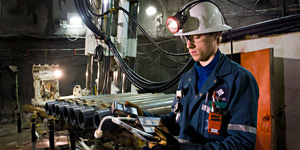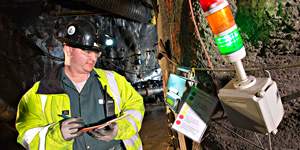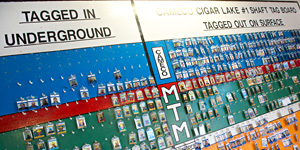The Top Priority
Safety is of paramount importance to all people who work in mining, but there are additional protective measures adopted by uranium mining compared to other types of metals mines. These measures exist to protect workers from uranium’s radioactive properties.
Protective measures are taken to reduce worker exposure to a number of radiation sources including gamma rays and alpha particles emitted by radon gas which develops from the natural decay of uranium.
The ALARA principle
ALARA is an acronym for As Low As Reasonably Achievable. The industry and its regulators use the internationally recognized ALARA principle to design protective measures and set regulatory limits for exposure. The ALARA limit for miners and other nuclear workers is based on the findings of the International Commission for Radiological Protection (ICRP), a United Nations agency whose research is shared with nuclear regulators from around the world.
The ICRP standard for nuclear workers is 50 milliSieverts (mSv), also the Canadian regulatory limit. However, international standards require that nuclear workers receive no higher than 20 mSv per year averaged over five years. As a result, individual mine and mill facilities in Canada employ the ALARA principle to set an individual dose target of no more than 20 mSv annually.
The effectiveness of mine radiation protection programs is confirmed in reports by regulators. In 2011, the average individual effective dose at Canadian underground uranium mines was below 1.4 mSv.
Source:
- the Canadian Nuclear Safety Commission’s CNSC Staff Report on Performance of Canadian Uranium Fuel Cycle and Processing Facilities, 2011
As a reference, the ICRP has determined the average additional dose above natural background levels for a member of the public should be 1 mSv annually.
Protective measures

To protect workers from exposure, the industry employs on-site specialists in radiation protection who monitor exposures and educate miners on work practices than help keep exposures low. As well, uranium companies employ health physicists to improve their radiation protection programs. Shielding and other protective measures such as high volume air ventilation are built into today’s uranium mine practices to keep exposures to a minimum.
Individual doses are reported monthly to regulators and kept on file by Health Canada’s National Dose Registry. The cumulative exposures are provided to individual workers each month by independent third parties.

To monitor individual exposures, workers are issued personal dosimeters. Optically stimulated luminescence dosimeters read external gamma exposure while personal alpha dosimeters measure exposure to long-lived radioactive dust and radon progeny.

In addition to the personal dosimeters monitors provided workers, specific areas of mines and mills where exposures are known to concentrate have monitoring stations that employ a highly visible “stop light” approach to keeping workers aware of exposures. For example, if the mitigation measures such as ventilation are temporarily ineffective in keeping radon gas levels at ALARA levels, the warning lights at the monitoring station will move from green to red and workers will leave the area until measures are taken to reduce exposures.
Conventional safety
The stringent documentation required to run an effective radiation protection program carries over to conventional mine safety programs.
Management systems, including human performance management programs, are subject to scrutiny within the nuclear licence of uranium mines and mills. Uranium mines and mills have adopted international standards (ISO) for occupational health and safety. Events, no matter how minor, are entered into an incident reporting system. What is learned from these incidents is shared at site safety meetings held at the beginning of each shift.

The effectiveness of conventional safety programs is evidenced by a general downward trend in the number of loss time incidents (LTIs) reported. Uranium mines and mills are among the best performing in accident prevention in the entire mining and industrial sector in Saskatchewan, the only jurisdiction in Canada where uranium mines and mills operate.






